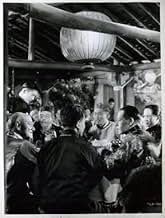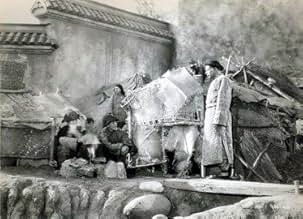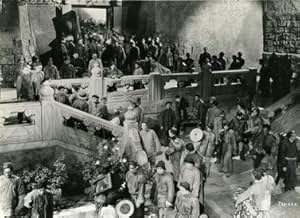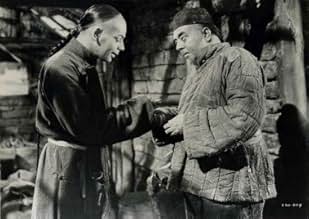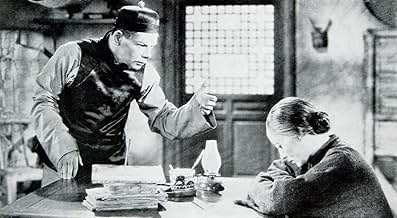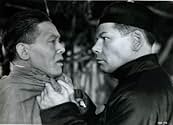Aggiungi una trama nella tua linguaAlthough married Chinese farmers Wang and O-Lan initially experience success, their lives are complicated by declining fortunes and lean times, as well as the arrival of the beautiful young ... Leggi tuttoAlthough married Chinese farmers Wang and O-Lan initially experience success, their lives are complicated by declining fortunes and lean times, as well as the arrival of the beautiful young Lotus.Although married Chinese farmers Wang and O-Lan initially experience success, their lives are complicated by declining fortunes and lean times, as well as the arrival of the beautiful young Lotus.
- Vincitore di 2 Oscar
- 7 vittorie e 3 candidature totali
- Revolutionary Army Captain
- (non citato nei titoli originali)
- Man
- (non citato nei titoli originali)
- Teahouse Dancer
- (non citato nei titoli originali)
- Chinese Girl
- (non citato nei titoli originali)
Recensioni in evidenza
I was particularly impressed by the camera work and the use of crowd scenes, especially during the sacking of the palace where O-Lan was once a slave. The graphic and grim atmosphere of the firing squad and the drought made this an epic quite unlike others of the same time where it was all glitz and glitter. I watched this film from beginning to end enthralled. I can't say the same for the "epics" of today.
From the very beginning of the picture, right after the lion's roar, we see the poignant tribute to Irving Thalberg, and we know that we are embarking on an important viewing experience. The scope of the story is very wide, and the filmmakers are up for the task. I was always struck by the abruptness of the final scene, but its power and beauty form an excellent example of the art achieved within the often cynical Hollywood film factory. And Lotus - the strangeness of her, and her dance, contrasted with the goodness of O-lan!
Aside from the oft-mentioned attributes of acting, photography and special effects, a major element in 'The Good Earth' is the score. Herbert Stothart may not be in the ranks of Hollywood's 'mighty handful' (Alfred Newman, Steiner, Tiomkin, Waxman, Herrmann), but his 'MGM-sound' scores regularly deliver the goods. True, Stothart had no hesitation in applying the syrup at first opportunity (one can imagine Louis B. Mayer positively ordering it), but in this picture, syrup gives way to sympathy. One of the pleasures of Hollywood's Golden Age films is that all the elements of a given film support each other, and great scores support not only the characters, but the entire film. Stothart's score is so sympathetic and so sincere, from the Main Title all the way through, and it enhances the story and the performances so naturally and at times transparently, that it must be considered a classic score. No great 'tunes' specifically, but plenty of effective mood, atmosphere and unabashed emotion. Many of today's audiences may find little to enjoy in such a combination, or they may be embarrassed by it, but I revel in it, as cinema such as this, which is delivered with such heart and good will is, especially in these times, nothing short of a gift.
The issue of non-Chinese playing Chinese characters has already been discussed on these pages, but I can only add: please, viewers, consider the film within the era that it was produced. The same kind of incongruity still happens today, perhaps not so much racially, but certainly culturally: Brad Pitt in 'Seven Years in Tibet', Keanu Reeves in 'Little Buddha', and other Americans getting plum roles in British-originated stories that become Hollywoodized, etc. When making 'Bhowani Junction', George Cukor considered using Indian actors, but vetoed any candidates in favor of familiar Hollywood faces. Never mind that in the 50s, as today, India had a huge film industry. It's just that those actors didn't fit into the Hollywood scheme of things. That speaks of box office more than political incorrectness. There is no doubt that fine actors like Philip Ahn should have gotten lead roles in pictures like 'The Good Earth', but at least we can enjoy them in supporting roles which carry a lot of weight in their own right. As time goes on, the context of past eras fades, while the films themselves, the really good ones, live on. There's plenty of opportunity for revisionist theses about issues like racial inequality in 1930s Hollywood, but for 138 minutes, it is compelling and moving to absorb onesself in the story and the atmosphere of 'The Good Earth'.
It was soap-operish at times but had some visually dramatic moments, too, capped off by a locust attack at the end of the film. That was astounding to view. Considering this film is about 70 years old, the special-effects crew on this film did a spectacular job.
Paul Muni and Luise Rainer were award-winning actors in their day and they don't disappoint here, both giving powerful performances. The only problem is credibility as all the Asians are played by Caucasions and some of them, like Walter Connolly, just don't look real. I'd like to see a re-make of this movie with all-Asian actors, not for PC reasons but to simply make the story look and sound more credible.
This was the first movie I saw at New York's Museum of Modern Art, around 1970 (I was a teenager). Expensive looking yet with scenes of such poverty, masterfully photographed, often thrilling, and always engaging, to me it was MGM movie-making at its best. What did audiences feel when they glimpsed a locust attack, the person by person destruction of a mansion, the horrific poverty and then the splendor of wealth.
Last week, those watching the Academy Awards had a glimpse of the "senior" Oscar winner in attendance, Luise Rainer. How grand to see an actress who arguably delivered one of the most masterful, haunting performances in history electing to return for a celebration.
Ok, so she should not have won the year before (Great Ziegfeld), but don't blame Luise. Talkies were only a decade old when this was released, and her dialogue limited. But as Olan, her use of visual and vocal is memorable.
Large scale and touching, what more could a movie lover want!
Lo sapevi?
- QuizSpecial effects experts were unable to produce an authentic-looking locust plague. Just as they were about to abandon the scene, they received word that a real locust plague was taking place several states away. A camera crew was rushed to the scene to capture it on film.
- Blooper(at around 2h 5 mins) Wang Lung is walking through the locust storm in his wheat field. He picks up a few men who have fallen down into the thick pile of locusts. In frustration, Wang shouts "I said save the wheat! Save it!" At this moment, a man dressed in 1937-era American clothing walks across the scene from left to right, at the top third of the screen. He is wearing a white hat and appears to be smoking a cigarette or cigar held in his left hand.
- Citazioni
Wang Lung: [must sell his land to feed his family but the buyers take advantage of him] Thieves! Thieves! And well you know I must sell.
O-Lan: No! Not the land. We'll not sell the land. We'll keep it. We'll go south and when we return, we'll still have the land.
Uncle: But I've arranged it. I brought these men here. You MUST sell!
O-Lan: Is it your land? Did you buy it bit by bit? The land is our life... and it's better to go south... or die walking... than to give it to you for nothing.
- Curiosità sui creditiIntroduction played with opening credits: The soul of great nation is expressed in the life of its humblest people. In this simple story of a Chinese farmer may be found something of a the soul of China - its humility, its courage, its deep heritage from the past and its vast promise for the future.
- ConnessioniEdited into La stirpe del drago (1944)
I più visti
Dettagli
- Data di uscita
- Paese di origine
- Sito ufficiale
- Lingua
- Celebre anche come
- The Good Earth
- Luoghi delle riprese
- Cedar City, Utah, Stati Uniti(backgrounds for locust sequence)
- Azienda produttrice
- Vedi altri crediti dell’azienda su IMDbPro
Botteghino
- Budget
- 2.800.000 USD (previsto)
- Tempo di esecuzione
- 2h 18min(138 min)
- Proporzioni
- 1.37 : 1



